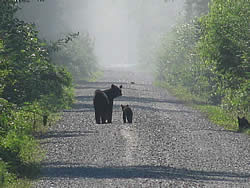Forests and Rangelands Success Story
Longest Burning Fire in Virginia Finally Out
Great Dismal Swamp National Wildlife Refuge, Virginia
National Fire Plan - Firefighting
2008

Black bear sow and cubs wander near the South One Fire. Credit: U.S. Fish and Wildlife Service.
Nearly four months after it started, the South One Fire, which ignited on the Great Dismal Swamp National Wildlife Refuge on June 9, has been declared fully extinguished by fire officials. The fire was originally started when logging equipment being used in fallen Atlantic White Cedar logging slash caught fire. The fire grew to 4,884 acres before being contained. Control lines around the fire were fully secured in early September and the fire was declared out on October 7.
After burning for 121 days, the South One Fire became the longest duration fire on record to ever burn in the state of Virginia. The cost to suppress the fire is expected to exceed $11 million. Hundreds of firefighters from federal, state and local agencies worked together to put the fire out.
"Being able to so smoothly work across state and regional lines with the National Wildlife Refuges in North Carolina to share personnel and resources was critical for us," said Tim Craig, Fire Management Officer for the refuge.
Over 240 people were assigned to work the incident at one point in early July. Fighting the fire involved operating equipment such as fire engines, bull dozers, water pumps and mowers.
The fire burned through slash on the ground created during logging operations to salvage cedar trees blown down during a 2003 hurricane. The flames crept deep into the peat soils where it continued to smolder and spread, eventually spreading back up to vegetation on the surface of the ground. The depth of the fire created lots of work for firefighters. Crews spent weeks flooding hot areas with an extensive water delivery system including multiple pumps and hoses to thoroughly soak hot spots to prevent the fire from growing.
Smoke lingered over the fire and into surrounding communities for many weeks as the vegetation continued to smolder. In late September, a coastal storm moved over the area dropping four to five inches of rain on the fire helping to drown any remaining heat.
The Great Dismal Swamp National Wildlife Refuge, located in southeastern Virginia and northeastern North Carolina, has a burned area recovery plan in place and will replant the rare Atlantic White Cedar stands that were affected. The refuge provides unique forested wetlands for migratory waterfowl including ducks, geese, and tundra swans. Many mammals also live on the refuge such as white-tailed deer. Visit the Great Dismal Swamp National Wildlife Refuge's website for more information.